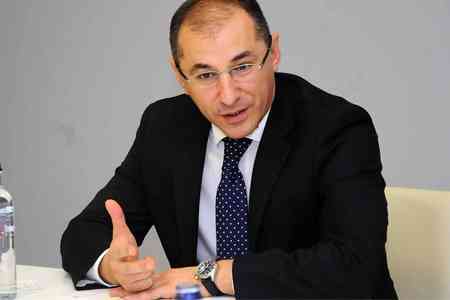


ArmInfo.If the factors causing AMD appreciation prove temporary, Armenia could face serious problems, ex-minister of finance of Armenia Vardan Aramyan said in an interview with the 5th Armenian channel.
Despite the USD appreciation, many countries, including Russia and Belarus, are recording appreciation of national currencies.
"The primary cause of appreciation of the Armenian dram is changes in Armenia's foreign trade pattern," he said. Specifically, western sanctions forced Russia to start trading in RUB terms, which has had a natural effect on its trade with Armenia. "Russian exports to Armenia are around $1.3bln. Armenia's annual payments for Russian gas alone total $460 to $480mln. So we have enormous surplus funds available amid the developments," he said.
A second factor determining AMD appreciation is the increasing number of people arriving in Armenia amid the Russian-Ukrainian confrontation - a four-fold increase from Russia alone. They exchange either Russian rubles or US dollars to Armenian dram thereby increasing demand for the Armenian currency. Money transfers from the USA and Russia have increased as well.
Mr Aramyan warns against making distinctly positive or negative assessments of the situation. Rather, the situation should be considered from the viewpoint of all the "beneficiaries".
Specifically, consumers benefit from AMD appreciation as it keeps the prices for imported goods down. The situation is also favorable to importers and non-exportable products - they former are reducing their USD expenditures and gaining advantage.
On the other hand, exporters are at a disadvantage as their profits are considerably decreasing amid increasing AMD expenditures. And only about 30% of exporters (those exporting to Russia) are in a relatively favorable situation, as the Armenian dram has not appreciated against the RUB.
According to Mr Aramyan, if the factors determining AMD appreciation are not permanent, Armenia could face serious problems (for example, similar to those in 2008 and 2009, when Armenia's economy recorded a decline of around 14%). Specifically, if the visitors to Armenia stay for a while or view Armenia as a transit country, we are going to see an opposite picture after they leave.
Under the circumstances, the AMD can go on appreciating thereby enabling Armenia to fill the gap between the actual and potential GDP, ensuring a balance or pursuing a sterilization policy by buying up USD surpluses and simultaneously draining the market of Armenian drams by means of government bond issues so as not to fuel inflation expectations with surplus funds.
Mr Aramyan is inclined to the second scenario despite the fact it is, in a sense, in line with inflation targeting. However, it will allow the AMD appreciation rates to be reduced. The Central Bank of Armenia (CBA) will build up some reserves and will be better prepared for the temporary nature of the factors determining AMD appreciation. The financial authorities' policy will support the export-orientated sector of Armenia's economy as well, which will prevent it from finding itself in a situation similar to that in the first decade of the 2000s. l
According to the CBA, the net inflow of private transfers to Armenia showed an accelerated year-on-year increase up to 94% this January-April against the 80% in the corresponding period last year, totaling $394.3mln, which was largely due to a manifold increase in transfers from Russia, whereas transfers from the USD were the primary cause of increase last January-April.
The inflow of private transfers to Armenia showed a 60.2% year-on-year increase this January-April against the 29.1% increase last January-April, totaling $981.6mln. Private transfers to Armenia from Russia showed a 2.2-fold year-on-year increase against a 9.4% increase last January-April, totaling $471.6mln.
The net inflow of transfers from Russia totaled $306.1mln, with a 3.2-fold accelerated year-on-year increase against the 5.2% increase last January-April. The private transfers to Armenia from the USA showed a 20% increase against a 2-fold increase last January-April, totaling $199.1, with the net increase in transfers from the USA being 5.8% against a 3-fold increase, totaling $115.2mln.
Russia's share in the inflow increased from 37.9% in January-April 2021 up to 51.3% this January-April, (51% in January-April 2019). The USA's share in the inflow of transfers decreased from 28.9% to 21% (against 15.3% in January-April 2019).